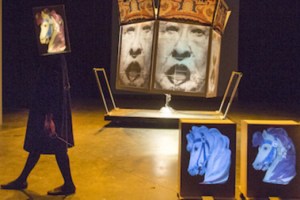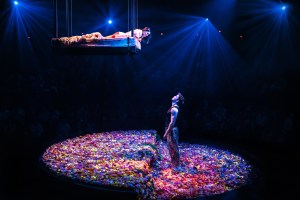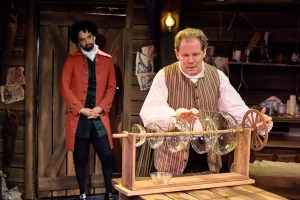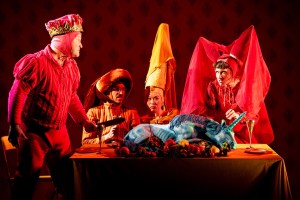Under the Radar 2020: Samuel Beckett's Not I and Feos
Jess Thom’s unique take on a Beckett classic and Aline Kuppenheim’s poignant puppetry come to the Public Theater’s annual festival of new works.
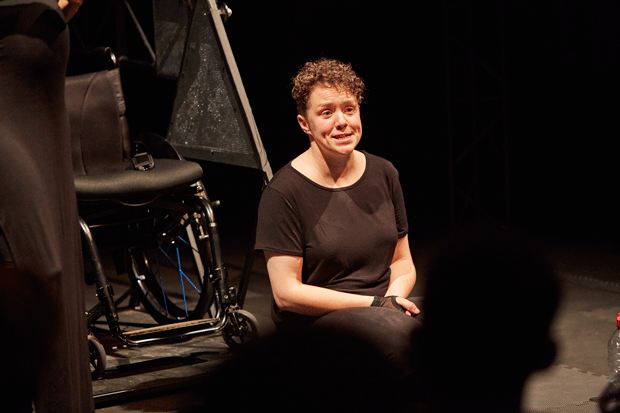
(© James Lyndsay)
Samuel Beckett's enigmatic Not I features a character named Mouth who unstops a ferocious, pent-up sluice of language for 12 minutes in a fragmented outburst about her life. Many of the words often escape audiences in the rapid-fire delivery, but Beckett didn't intend it all to be understood. As he told one of its early performers, Jessica Tandy, the piece was meant to "work on the nerves of the audience, not its intellect."
British actor Jess Thom, who has Tourette's syndrome, saw a kindred spirit in Mouth and decided she wanted to take on the formidable role. With the blessing of the Beckett estate and the help of an incredible creative team, Thom has put together a brilliant theatrical and communal experience around the play that New York audiences can — and should — see as part of the Public's Under the Radar festival.
It's obvious upon entering the theater that Thom has more in store for the audience than a performance of Beckett's play. Seating includes pillows and mats on the floor, as well as benches, and the atmosphere is relaxed, meaning that any and all, including those who need to move or speak during the show, are welcome. Following the performance, we watch a film about Thom's journey with the play, from her initial email to the Beckett estate, to her rehearsals, to the construction of the chair that lifts her into the air.
Her performance and interactions with the audience are peppered with verbal and physical tics, most often her repetition of the word biscuit accompanied by a chest thump. ASL performer Lindsey D. Snyder signs every word Thom speaks, including the verbal tics. Far from distracting, Thom's tics enrich Mouth's torrent of words with unexpected significance.
Thom's personality is so gracious and open that it feels natural segueing into the next segment of the show, in which audience members turn to a neighbor and talk about their reactions to the performance. I spoke with a woman named Rachel, who was already familiar with Thom's work. At the end of the show, the audience is encouraged to shout, or speak loudly, or do whatever comes naturally in one huge communal outburst of uninhibited emotion. It's an exercise in broadening our ideas of what behaviors are appropriate in theaters, and in making the experience of theater open to everyone.
I left the BRIC in Brooklyn with sense of elation that doesn't often occur after I exit a theater. In the span of an hour, Jess Thom does something extraordinary: She turns Beckett's Not I into We.
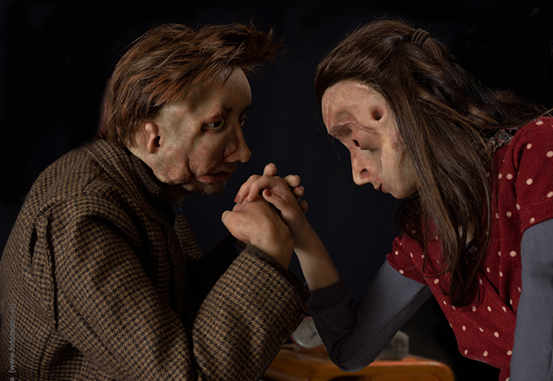
(© Elio Frugone Piña)
The title of puppet artist Aline Kuppenheim's Feos translates from the Spanish to something like "ugly people." That's a blunt description that strikes an uncomfortable chord in an era when any sort of body-shaming is a cancelable offense. But the title speaks to the unabashed honesty and directness with which the characters of this haunting and memorable work, running at the Public Theater as part of its Under the Radar festival, look at themselves and their lives.
Playwright Guillermo Calderón based the script for this 50-minute show, which combines cinema and startlingly realistic puppetry, on Mario Beneditti's short story "Noche de los Feos." A man and a woman whose faces have been severely disfigured meet in a movie theater and later talk over coffee about their isolation and their desire to be like "normal" people. Their conversation leads them to seek solace in each other's arms for one night of tremulous, fragile passion.
Kuppenheim, who directs this remarkably poignant story, creates a small world around this lifelike puppet couple using images (designed by Tomás Arias) projected onto a scrim to place them in the play's three locales: the cinema, the café, and the man's bedroom. Five puppeteers clad in black move the man and woman (as well as a puppet waiter who enters now and then to offer some ham-fisted anecdotes to the couple) in subtle ways: The woman anxiously crosses her ankles; the man diffidently massages his leg.
Throughout, Calderón's dialogue (in Spanish with subtitles projected on the scrim) crackles with deep insight into the minds of these two characters, who look at their realities with unflinching frankness: They are, they admit, ugly people whom others are happy not to be. Their appearances exclude them from friendships and elicit predictable responses from strangers: The woman says people assume that she is kind and gentle, but the man says he's often assumed to be wicked, though, he confides, he wishes he was good-looking enough to be a jerk the way other men get to be.
Feos bristles with uncomfortable observations about the way we judge others based on appearances. It would be easy to draw lessons from it regarding how we interact with other people: Don't assume you know a person from the way they look; be sensitive to those who are different. Those takeaways, however well-meaning, oversimplify the story. Feos is ultimately about two people who have been dealt difficult hands yet are still trying to make a connection in this hostile, lonely world. It's an achingly human love story, and if you look closely, you're likely to see yourself in their faces.



